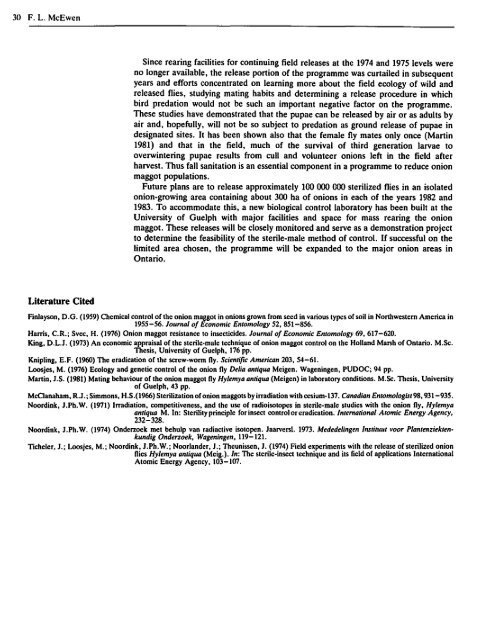pdf, 57.71Mb - Entomological Society of Canada
pdf, 57.71Mb - Entomological Society of Canada
pdf, 57.71Mb - Entomological Society of Canada
You also want an ePaper? Increase the reach of your titles
YUMPU automatically turns print PDFs into web optimized ePapers that Google loves.
30 F. L. McEwen<br />
Literature Cited<br />
Since rearing facilities for continuing field releases at the 1974 and 1975 levels were<br />
no longer available, the release portion <strong>of</strong> the programme was curtailed in subsequent<br />
years and efforts concentrated on learning more about the field ecology <strong>of</strong> wild and<br />
released flies, studying mating habits and determining a release procedure in which<br />
bird predation would not be such an important negative factor on the programme.<br />
These studies have demonstrated that the pupae can be released by air or as adults by<br />
air and, hopefully, will not be so subject to predation as ground release <strong>of</strong> pupae in<br />
designated sites. It has been shown also that the female fly mates only once (Martin<br />
1981) and that in the field, much <strong>of</strong> the survival <strong>of</strong> third generation larvae to<br />
overwintering pupae results from cull and volunteer onions left in the field after<br />
harvest. Thus fall sanitation is an essential component in a programme to reduce onion<br />
maggot populations.<br />
Future plans are to release approximately 100 000 000 sterilized flies in an isolated<br />
onion-growing area containing about 300 ha <strong>of</strong> onions in each <strong>of</strong> the years 1982 and<br />
1983. To accommodate this, a new biological control laboratory has been built at the<br />
University <strong>of</strong> Guelph with major facilities and space for mass rearing the onion<br />
maggot. These releases will be closely monitored and serve as a demonstration project<br />
to determine the feasibility <strong>of</strong> the sterile-male method <strong>of</strong> control. If successful on the<br />
limited area chosen, the programme will be expanded to the major onion areas in<br />
Ontario.<br />
Finlayson, D.G. (1959) Chemical control <strong>of</strong> the onion maggot in onions grown from seed in various types <strong>of</strong> soil in Northwestern America in<br />
1955-56. Journal <strong>of</strong> Economic Entomology 52, 851-856.<br />
Harris, C.R.; Svec, H. (1976) Onion maggot resistance to insecticides. Journal <strong>of</strong> Economic Entomology 69, 617-620.<br />
King, D.L.J. (1973) An economic appraisal <strong>of</strong> the sterile-male technique <strong>of</strong> onion maggot control on the Holland Marsh <strong>of</strong> Ontario. M.Sc.<br />
Thesis, University <strong>of</strong> Guelph, 176 pp.<br />
Knipling, E.F. (1960) The eradication <strong>of</strong> the screw-worm Oy. Scientific American 203, 54-61.<br />
Loosjes, M. (1976) Ecology and genetic control <strong>of</strong> the onion Oy Delia antiqua Meigen. Wageningen, PUDOC; 94 pp.<br />
Martin, J.S. (1981) Mating beha\;our <strong>of</strong> the onion maggot Oy Hylemya antiqua (Meigen) in laboratory conditions. M.Sc. Thesis, University<br />
<strong>of</strong> Guelph, 43 pp.<br />
McCIanaham, R.J.; Simmons, H.S.(1966) Sterilization <strong>of</strong> onion maggots by irradiation with cesium-137. Canadian Entomologist 98, 931-935.<br />
Noordink, J.Ph.W. (1971) Irradiation, competitiveness, and the use <strong>of</strong> radioisotopes in sterile-male studies with the onion Oy, Hylemya<br />
antiqua M. In: Sterility principle forinsect control or eradication. International Aromic Energy:Agency,<br />
232-328.<br />
Noordink, J.Ph.W. (1974) Onderzoek met behulp van radiactivc isotopen. Jaarversl. 1973. Mededelingen Instituut voor Plantenziektenkundig<br />
Onderzoek, Wageningen, 119-121.<br />
Ticheler, J.; Loosjes, M.; Noordink, J.Ph. W.; Noorlandcr, J.; Theunissen, J. (1974) Field experiments with the release <strong>of</strong> sterilized onion<br />
Dies Hylemya antiqua (Meig.). In: The sterile-insect technique and its field <strong>of</strong> applications International<br />
Atomic Energy Agency, 103-107.
















